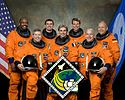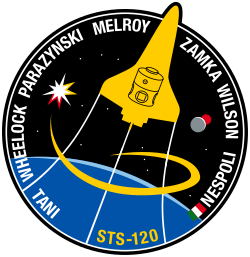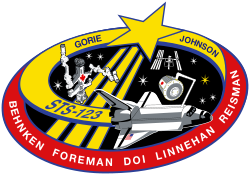STS-122
| STS-122 | |||||
 | |||||
| Uppdrag | 121 | ||||
|---|---|---|---|---|---|
| Rymdfärja | Atlantis (29) | ||||
| NSSDC-ID | 2008-005A[1] | ||||
| Färdens tid | 12 dagar, 18 timmar, 22 minuter, 38 sekunder | ||||
| Uppskjutning | |||||
| Startplats | Startplatta 39A vid Kennedy Space Center i Florida | ||||
| Start | 7 februari 2008, 19:45 UTC | ||||
| Landning | |||||
| Landningsplats | Kennedy Space Center | ||||
| Landning | 20 februari 2008, 14:07 UTC | ||||
| Omloppsbana | |||||
| Varv | 202 st[2] | ||||
| Apogeum | 234 km | ||||
| Perigeum | 215 km | ||||
| Banlutning | 51,6° | ||||
| Sträcka | 8,5 miljoner km | ||||
| Rymdpromenad | |||||
| Antal | 3 st | ||||
| Total tid | 22 timmar, 8 minuter | ||||
| Dockning | |||||
| Rymdstation | ISS | ||||
| Dockning | 9 februari 2008, 17:17 UTC | ||||
| Dockningsport | PMA-2 (Harmony, fram) | ||||
| Urdockning | 18 februari 2008, 09:24 UTC | ||||
| Tid dockad | 8 dagar, 16 timmar, 7 minuter | ||||
| Besättning | |||||
| Befälhavare | Stephen N. Frick (2) | ||||
| Pilot | Alan G. Poindexter (1) | ||||
| Uppdragsspecialister | Stanley G. Love (1) Rex J. Walheim (2) Leland D. Melvin (1) Hans Schlegel (2) ESA | ||||
 | |||||
| Kronologi Rymdfärjeprogrammet | |||||
| |||||
STS-122 var en rymdfärd till den internationella rymdstationen ISS som genomfördes av den amerikanska rymdfärjan Atlantis. Rymdfärjan lyfte från Kennedy Space Center den 7 februari 2008. Starten skulle egentligen ägt rum den 6 december 2007, men på grund av tekniska problem med sensorer i den externa bränsletanken försenades den. Uppdraget hade som mål att leverera och installera modulen Columbus. Efter landningen skulle rymdfärjan komma att förberedas för nästa uppdrag STS-125, ett sista serviceuppdrag för Rymdteleskopet Hubble. Atlantis landade på bana 15 på Kennedy Space Center den 20 februari 2008 efter nästan 13 dagar i rymden. Atlantis avslutade därmed sitt 29:e uppdrag till rymden och sin 9:e färd till ISS.
Höjdpunkter
STS-122 var ISS Assembly Flight 1E och förde Columbus till stationen tillsammans med annan utrustning. Ett felande gyroskop (CMG) byttes ut under STS-118 och återfördes till Jorden under detta uppdrag.
Aktiviteter
Före uppskjutning
Atlantis fördes ut till startplatta 39A den 10 november 2007.
Förseningar
STS-122 skulle ursprungligen ha skjutits upp den 6 december 2007, men på grund av problem med sensorn som ska separera motorerna, flyttades uppskjutningen fram till den 9 december.[3] Under detta andra uppskjutningsförsök fortsatte dessa sensorer att krångla, och uppskjutningen sköts återigen upp.[4] Ett tankningstest den 18 december avslöjade att det troliga felet var kopplingens position. Kopplingen flyttades och uppskjutningen flyttades nu till den 7 februari, 2008, då den slutligen lyckades.[5][6]
Uppskjutning

Tankningen började 10:26 UTC. Alla bränslesensorer hade fungerat som planerat, och kl 19:35, gav uppskjutningschefen Doug Lyons Atlantis besättning klartecken att påbörja uppskjutningen.[7] Atlantis sköts upp planenligt 19:45 UTC.[8] Huvudmotorn lossade 19:54 UTC.[7][9]
Under starten såg man att ett antal isklumpar eller något annat material som lossnade från bränsletanken. Dessa ansågs inte utgöra någon risk så Atlantis fick grönt ljus att landa vid återkomsten 13 dagar senare utan några vidare inspektioner.
Aktiviteter dag för dag

Dag 1: Atlantis värmesköldar undersöks med rymdfärjans robotarm och lastluckorna öppnas. Förberedelser inför dockning med ISS.
Dag 2: Dockning med den internationella rymdstationen ISS, som inträffar ca. 18.17 svensk tid. En timme senare öppnas luckorna mellan de två farkosterna.
Dag 3: De tre första rymdpromenaderna flyttas fram en dag på grund av att Hans Schlegel inte mår bra. ESA bekräftar senare att det inte är något allvarligt.
Dag 4: EVA 1, Walheim och Love utför den första rymdpromenaden. Modulen Columbus får första kontakten med rymdstationen 21:29 UTC, och vid 21:44 meddelas att den sitter fast på ISS.
Dag 5: Aktivering av Columbus samt uppkoppling på ISS elnätverk. Förberedelser inför den andra rymdpromenaden.
Dag 6: EVA 2, Walheim och Schlegel utför den andra rymdpromenaden.
Dag 7: Installation av system i Columbus och planering inför EVA 3.

Dag 8: EVA 3, Walheim och Love utför den tredje rymdpromenaden. SOLAR telescope installeras under rymdpromenaden.
Dag 9: Man fortsatte att sammankoppla Columbus med ISS. Besättningen håller mediakonferenser med både amerikansk och europeisk press.
Dag 10: De sista arbetena med Columbus-modulen fortsätter, och på kvällen tar astronauterna och besättningen på ISS farväl av varandra och luckorna mellan farkosterna stängs.
Dag 11: Ca. 10.30 svensk tid lämnar Atlantis ISS. Värmesköldar inspekteras inför landningen.
Dag 12: Fortsatta förberedelser inför landningen, samt intervjuer med amerikansk media.
Dag 13: Atlantis landar kl. 15.07 svensk tid på Kennedy Space Center och därmed avslutas uppdrag STS-122.
Rymdpromenader
EVA 1: Förberedelser med att föra över Columbus från Atlantis lastutrymme till ISS. Rymdpromenaden utfördes av Walheim och Love och var lyckad.
EVA 2: Fortsatt arbete med Columbus bland annat för att montera värmesköldar på modulen. Astronauterna bytte även ut en utvändig kvävetank. Även de sista elkablarna på kraftsystemet drogs om. Rymdpromenaden utfördes av Walheim och Schlegel och var lyckad.
EVA 3: Förflyttning av ett trasigt gyroskop från dess tillfälliga plats på ISS, det fraktades till Atlantis lastutrymme. Fler värmeskydd på Columbus monterades, och även ett antal handtag. Walheim och Love utförde rymdpromenaden.
Besättning
 USA Stephen N. Frick, befälhavare. (2).
USA Stephen N. Frick, befälhavare. (2). USA Alan G. Poindexter, pilot. (1).
USA Alan G. Poindexter, pilot. (1). USA Stanley G. Love, uppdragsspecialist. (1).
USA Stanley G. Love, uppdragsspecialist. (1). USA Rex J. Walheim, uppdragsspecialist. (2).
USA Rex J. Walheim, uppdragsspecialist. (2). USA Leland D. Melvin, uppdragsspecialist. (1).
USA Leland D. Melvin, uppdragsspecialist. (1). Tyskland Hans Schlegel ESA, uppdragsspecialist. (3).
Tyskland Hans Schlegel ESA, uppdragsspecialist. (3).
Besättning på ISS som byttes i och med detta uppdrag
 Frankrike Léopold Eyharts ESA, uppdragsspecialist. Reste med Atlantis för att ingå i Expedition 16 på ISS. (2).
Frankrike Léopold Eyharts ESA, uppdragsspecialist. Reste med Atlantis för att ingå i Expedition 16 på ISS. (2). USA Daniel M. Tani, uppdragsspecialist. Återvänder till jorden från Expedition 16.
USA Daniel M. Tani, uppdragsspecialist. Återvänder till jorden från Expedition 16.
Siffran inom parentes anger antal rymdfärder inklusive denna som personen gjort.
Atlantis medverkan i bygget av ISS
Detta var Atlantis nionde besök på den Internationella rymdstationen. Atlantis hade därmed levererat och installerat modulerna; Destiny, Quest Airlock, Columbus samt merparten av truss.
Atlantis deltog även i bygget av den ryska rymdstationen Mir. I juni 1995 blev Atlantis den första rymdfärja att docka med Mir. Atlantis gjorde ytterligare sex resor till Mir, och levererade bland annat en dockningsmodul som rymdfärjorna sedan använde sig av.
Väckningar
Under Geminiprogrammet började NASA spela musik för besättningar och sedan Apollo 15 har man varje "morgon" väckt besättningen med ett särskilt musikstycke, särskilt utvalt antingen för en enskild astronaut eller för de förhållanden som råder.
| Dag | Låt | Artist/Kompositör | Spelad för | Länk |
|---|---|---|---|---|
| 2 | The Book of Love | Peter Gabriel, | Léopold Eyharts | WAV MP3 |
| 3 | The Prairie Home Companion Theme Song | Pat Donohue och Guy's All-Star Shoe Band (intro och sång Garrison Keillor) | Stephen N. Frick | WAV MP3 |
| 4 | Männer | Herbert Grönemeyer, | Hans Schlegel | WAV MP3 |
| 5 | Fly Like an Eagle | Yolanda Adams | Leland Melvin | WAV MP3 |
| 6 | Dream Come True | Jim Brickman | Rex J. Walheim | WAV MP3 |
| 7 | Oysters and Pearls | Jimmy Buffett | Alan G. Poindexter | WAV MP3 |
| 8 | Consider Yourself | Oliver! | Stanley G. Love | WAV MP3 |
| 9 | Marmor, Stein und Eisen Bricht | Drafi Deutscher | Hans Schlegel | WAV MP3 |
| 10 | I Believe I Can Fly | Yolanda Adams | Leland Melvin | WAV MP3 |
| 11 | Hail Thee, Harvey Mudd | Harvey Mudd College | Stanley G. Love | WAV MP3 |
| 12 | Over the Rainbow / What a Wonderful World | Israel Kamakawiwo'ole | Daniel M. Tani | WAV MP3 |
| 13 | Always Look on the Bright Side of Life (Spamalot rendition), | Eric Idle | Stephen N. Frick | WAV MP3 |
| 14 | Hail to the Spirit of Liberty | John Philip Sousa | Alan G. Poindexter | WAV MP3 |
Se även
Referenser
- ^ ”NASA Space Science Data Coordinated Archive” (på engelska). NASA. https://nssdc.gsfc.nasa.gov/nmc/spacecraft/display.action?id=2008-005A. Läst 22 mars 2020.
- ^ Manned Astronautics - Figures & Facts Arkiverad 16 augusti 2016 hämtat från the Wayback Machine., läst 28 juli 2016.
- ^ Chris Bergin (2007). ”STS-122 launch attempt scrubbed - ET sensor issue”. NASA Spaceflight.com. http://www.nasaspaceflight.com/content/?cid=5302. Läst 6 december 2007.
- ^ Chris Bergin (2007). ”PRCB debates STS-122 options - includes rollback and tank swap”. NASA Spaceflight.com. http://www.nasaspaceflight.com/content/?cid=5319. Läst 29 december 2007.
- ^ Chris Bergin (January 13, 2008). ”STS-122: Engineers install ET-125's modified connector”. NASA Spaceflight.com. http://www.nasaspaceflight.com/content/?cid=5330. Läst 17 januari 2008.
- ^ NASA (January 11, 2008). ”NASA Announces Space Shuttle Launch Targets”. National Aeronautics and Space Administration. http://www.nasa.gov/home/hqnews/2008/jan/HQ_M0806_Shuttle_Launch_Dates.html. Läst 11 januari 2008.
- ^ [a b] Miles O'Brien and Associated Press (2008). ”Shuttle blasts into space”. CNN. Arkiverad från originalet den 9 februari 2008. https://web.archive.org/web/20080209164315/http://www.cnn.com/2008/TECH/space/02/07/spaceshuttle.ap/index.html. Läst 7 februari 2008.
- ^ NASA (2008). ”NASA's Shuttle Atlantis Begins Mission to the Space Station”. NASA. http://www.nasa.gov/home/hqnews/2008/feb/HQ_08035_STS-122_Launch.html. Läst 8 februari 2008.
- ^ NASA (2008). ”NASA's STS-122 Launch Blog”. NASA. http://www.nasa.gov/mission_pages/shuttle/shuttlemissions/sts122/launch/launchblogpage.html. Läst 7 februari 2008.
Externa länkar
 Wikimedia Commons har media som rör STS-122.
Wikimedia Commons har media som rör STS-122.- NASA:s webbsida om STS-122
- Svensk webbsida om STS-122
| ||||||||
| |||||||||||||||||||||||||||||||
| ||||||||||||||||||||||||||||||||
Media som används på denna webbplats
Författare/Upphovsman: Pascal (Flickr user: pasukaru76), Licens: CC0
Vostok spacecraft replica at the Technik Museum Speyer, Germany.
Columbus module
The STS-122 patch depicts the continuation of the voyages of the early explorers to today's frontier, space. The ship denotes the travels of the early expeditions from the east to the west. The space shuttle shows the continuation of that journey along the orbital path from west to east. A little more than 500 years after Columbus sailed to the new world, the STS-122 crew will bring the European laboratory module "Columbus" to the International Space Station to usher in a new era of scientific discovery.
In this illustration, a SpaceX Crew Dragon spacecraft approaches the International Space Station for docking. NASA is partnering with Boeing and SpaceX to build a new generation of human-rated spacecraft capable of taking astronauts to the station and expanding research opportunities in orbit. SpaceX's upcoming Demo-1 flight test is part of NASA’s Commercial Crew Transportation Capability contract with the goal of returning human spaceflight launch capabilities to the United States.
STS122-S-002 (24 April 2007) --- These seven astronauts take a break from training to pose for the STS-122 crew portrait. From the left (front row) are astronauts Stephen N. Frick, commander; European Space Agency's (ESA) Leopold Eyharts; and Alan G. Poindexter, pilot. From the left (back row) are astronauts Leland D. Melvin, Rex J. Walheim, Stanley G. Love and European Space Agency's (ESA) Hans Schlegel, all mission specialists. Eyharts will join Expedition 16 in progress to serve as a flight engineer aboard the International Space Station. The crewmembers are attired in training versions of their shuttle launch and entry suits.
The space shuttle Atlantis touches down on Runway 15 of the Shuttle Landing Facility at NASA's Kennedy Space Center. The shuttle landed on orbit 202 to complete the 13-day STS-122 mission. Main gear touchdown was 9:07:10 a.m. Nose gear touchdown was 9:07:20 a.m. Wheel stop was at 9:08:08 a.m. Mission elapsed time was 12 days, 18 hours, 21 minutes and 44 seconds. During the mission, Atlantis' crew installed the new Columbus laboratory, leaving a larger space station and one with increased science capabilities. The Columbus Research Module adds nearly 1,000 cubic feet of habitable volume and affords room for 10 experiment racks, each an independent science lab.
Backdropped by a blue and white Earth, this close-up view features the Soyuz TMA-6 spacecraft approaching the International Space Station (ISS). Onboard the spacecraft are cosmonaut Sergei K. Krikalev, Expedition 11 commander representing Russia's Federal Space Agency; astronaut John L. Phillips, NASA ISS science officer and flight engineer; and European Space Agency (ESA) astronaut Roberto Vittori of Italy. The Soyuz linked to the Pirs Docking Compartment at 9:20 p.m. (CDT) on April 16, 2005 as the two spacecraft flew over eastern Asia. The docking followed Friday’s launch from the Baikonur Cosmodrome in Kazakhstan.
Billows of smoke and steam nearly obscure the twin columns of fire boosting space shuttle Atlantis into space for a rendezvous with the International Space Station on mission STS-122. Liftoff was on time at 2:45 p.m. EST.
The STS-120 patch reflects the role of the mission in the future of the space program. The shuttle payload bay carries Node 2, the doorway to the future international laboratory elements on the International Space Station. On the left the star represents the International Space Station; the red colored points represent the current location of the P6 solar array, furled and awaiting relocation when the crew arrives. During the mission, the crew will move P6 to its final home at the end of the port truss. The gold points represent the P6 solar array in its new location, unfurled and producing power for science and life support. On the right, the moon and Mars can be seen representing the future of NASA. The constellation Orion rises in the background, symbolizing NASA's new exploration vehicle. Through all, the shuttle rises up and away, leading the way to the future.
Rotated and color enhanced version of original (ISS013-E-48788 (6 July 2006) --- The Space Shuttle Discovery approaches the International Space Station for docking but before the link-up occurred, the orbiter went through a series of inspection photos by station crew to inspect the vehicle for any damage to its Thermal Protection System. This was known as the Rendezvous Pitch Maneuver and was implemented after the Columbia Disaster in 2003. The Leonardo Multipurpose Logistics Module can be seen in the shuttle's cargo bay. Discovery docked at the station's Pressurized Mating Adapter 2 at 9:52 a.m. CDT, July 6, 2006.)
STS-123 continues assembly of the International Space Station (ISS). The primary mission objectives include rotating an expedition crew member and installing both the first component of the Japanese Experimental Module (the Experimental Logistics Module - Pressurized Section (ELM-PS)) and the Canadian Special Purpose Dexterous Manipulator (SPDM). In addition, STS-123 will deliver various spare ISS components and leave behind the sensor boom used for inspecting the shuttle's thermal protection system. A follow-on mission to ISS will utilize and then return home with this sensor boom. A total of five spacewalks are planned to accomplish these tasks. The mission will also require the use of both the shuttle and ISS robotic arms. STS-123 will utilize the Station-Shuttle Power Transfer System to extend the docked portion of the mission to eleven days, with a total planned duration of 15 days. The crew patch depicts the space shuttle in orbit with the crew names trailing behind. STS-123's major additions to ISS (the ELM-PS installation with the shuttle robotic arm and the fully constructed SPDM) are both illustrated. The ISS is shown in the configuration that the STS-123 crew will encounter when they arrive.
















